The Academy of Pediatrics' statement on kids' health and the built environment, along with a guest's small-town reverie

Posted May 29, 2009 at 1:27PM
Earlier this week the American Academy of Pediatrics issued a well-researched and -referenced policy statement: In sum, sprawl is not good for our children's health. Old-fashioned neighborhoods are, and so may be newer smart growth based on traditional neighborhood models.
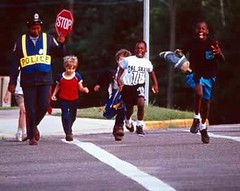 In particular, says the Academy, 32 percent of our kids are overweight, in part because they don't get enough exercise. With the prevalence of school sprawl making it all but impossible to walk to school anymore for most children, and neighborhood layouts that keep us separated from shops and activities, with poor street connectivity, our built environment actually discourages exercise. This needs to be remedied through policy initiatives.
In particular, says the Academy, 32 percent of our kids are overweight, in part because they don't get enough exercise. With the prevalence of school sprawl making it all but impossible to walk to school anymore for most children, and neighborhood layouts that keep us separated from shops and activities, with poor street connectivity, our built environment actually discourages exercise. This needs to be remedied through policy initiatives.
The policy statement is published in Pediatrics, the Academy's official journal, and was authored by Drs. June Tester, MD, MPH, and Richard Jackson, MD, MPH. I don't know Dr. Tester, but Dick is a giant in the field, and a good guy, too. He formerly headed up the environmental health section at the federal Centers for Disease Control and Prevention. Bravo to the authors and the Academy for stepping up.
This led my longtime friend and collaborator Lee Epstein, who directs the Lands Program at the Chesapeake Bay Foundation, to put the report in a very personal context, which I am now honored to share with you:
Just a few days ago, the American Academy of Pediatrics issued a new policy statement, "The Built Environment: Designing Communities to Promote Physical Activity in Children." This notable statement from preeminent children's health professionals reminded me of my own smart growth past.
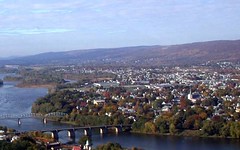 I grew up in the 1960s in a small town (approximately a square mile in size, with a population about 7,000), adjacent to other small towns in a highly-urbanized area of Pennsylvania. The tree-lined blocks were short and as square as a few modest hills allowed, and there were lots of alleys. There were churches galore, a high school, middle, and elementary school (the latter two with adjacent concrete playgrounds - remember those?); a lovely, long riverfront park that embraced about half the town; two or three small business areas with a few shops, offices, a bank or two, and a few family restaurants; and a light industrial area near the railroad tracks.
I grew up in the 1960s in a small town (approximately a square mile in size, with a population about 7,000), adjacent to other small towns in a highly-urbanized area of Pennsylvania. The tree-lined blocks were short and as square as a few modest hills allowed, and there were lots of alleys. There were churches galore, a high school, middle, and elementary school (the latter two with adjacent concrete playgrounds - remember those?); a lovely, long riverfront park that embraced about half the town; two or three small business areas with a few shops, offices, a bank or two, and a few family restaurants; and a light industrial area near the railroad tracks.
There was a community pool, a little league park, a library, the high school football stadium (this was Pennsylvania, after all), a few tennis and basketball courts, and even a golf course. There were a few acres of open fields for pick-up baseball games. 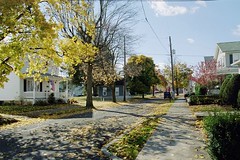 Across the river was another, bigger town with a pretty significant commercial area, where Dad worked. He walked the half hour to work as much as he drove.
Across the river was another, bigger town with a pretty significant commercial area, where Dad worked. He walked the half hour to work as much as he drove.
It was a kid's paradise. Biking to any friend's house or up to the little league field or the community pool took 10 minutes, racing through the back alleys. We walked to school, scouts, and (some of us) to church. We sometimes walked for a few groceries, to the pizza place or the drug store - all on our own from an early age. Houses were close together and the stock was solid and widely affordable if not spectacular (except for the century-old homes along the riverfront), with a mix of singles, duplexes, and the few quads and scattered, second-floor apartments above the businesses. We could (and did) have plenty of kid-type adventures along the river, and a low, forested mountain on the other side of town provided additional outdoor access about twenty minutes away by bike.
Enough of the nostalgia. This isn't an idyll, and it wasn't utopia. I was bored to tears as a teenager, and happy to escape. (The place has changed a fair bit now, mostly not for the better. The bustling town across the river is now nearly an empty shell, hosting a few bars and some state services -- the big malls killed it by the late 1970's.)
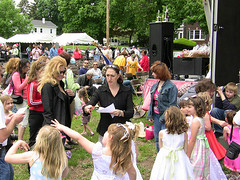 But the frame of reference is a valid one, I think, for some of the qualities that help create a sense of place, a feeling of security and well-being, and importantly, a healthy life-style for children and families. The design model (small blocks with alleys, local parks and schools, the mix of local-serving businesses, even a park along the river) still has great value, whether applied to a big city, a small town, or an urban county.
But the frame of reference is a valid one, I think, for some of the qualities that help create a sense of place, a feeling of security and well-being, and importantly, a healthy life-style for children and families. The design model (small blocks with alleys, local parks and schools, the mix of local-serving businesses, even a park along the river) still has great value, whether applied to a big city, a small town, or an urban county.
Of course, making the economic model work as well as the design model may not be as easy. People today like shopping where there's some selection, diversity, and panache, none of which we had in our little town (though at least the first two qualities did exist for 75 years along Main Street, across the river). 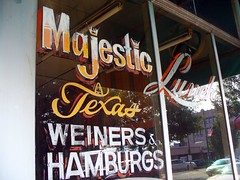 And a little more density surely wouldn't hurt -- though obtaining it in that setting wouldn't have been easy then, nor today either.
And a little more density surely wouldn't hurt -- though obtaining it in that setting wouldn't have been easy then, nor today either.
But the bottom line is that, given its location and other qualities, with some added energy and water-saving techniques, adequate transit for connection to other places, an updated and re-energized commercial core, and a few more people, if that little town were built today it would surely meet the needs and have the attributes noted as especially useful by the pediatricians in their policy statement. Today, it might even qualify for LEED-ND. Who knew?
Extremely well said. Many thanks to Lee, who grew up in West Pittston, Pennsylvania. Download the full text of the Academy's policy statement here.